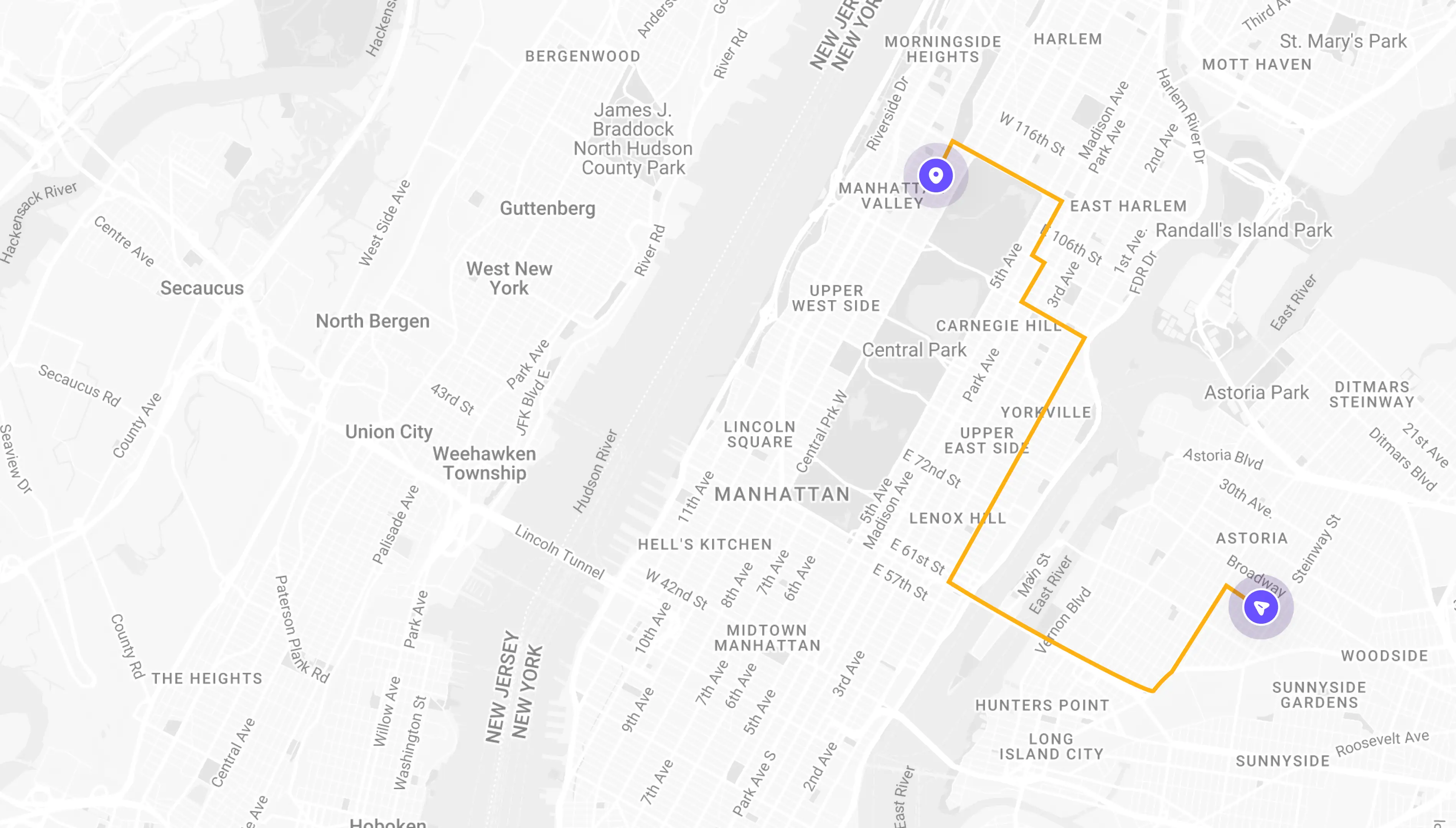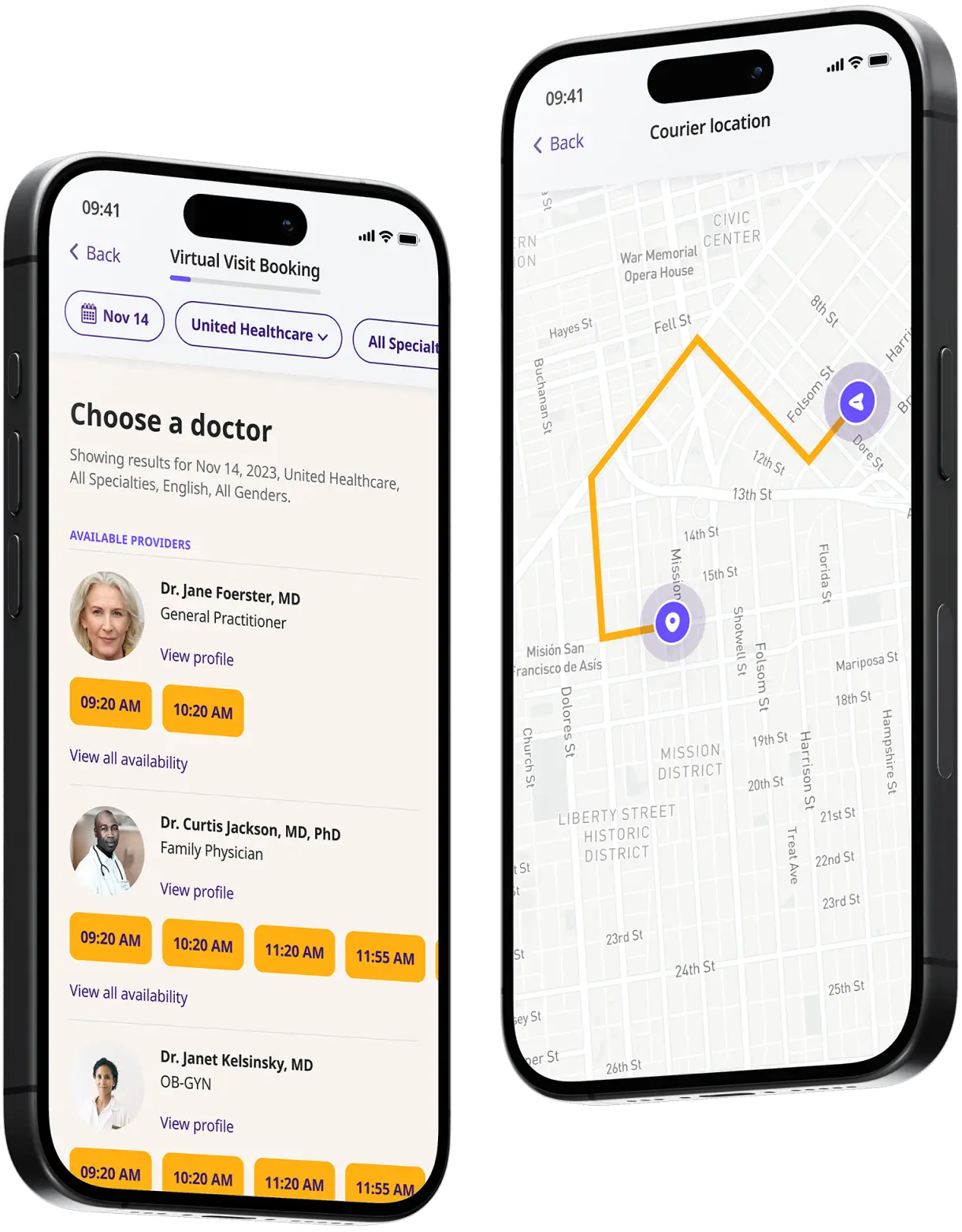Back Pain Treatment Online
Ease back pain with expert online care. Consult with a virtual doctor for personalized treatment and prescriptions.

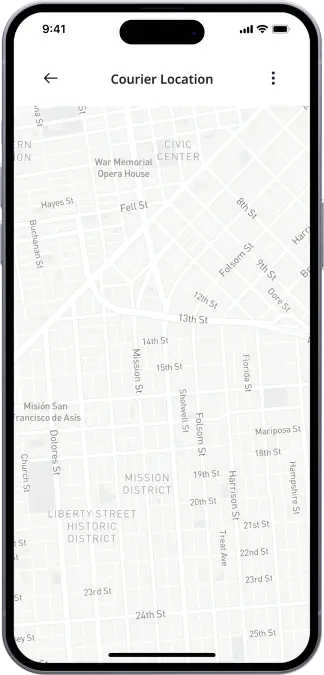
Available in 50 states. Insurance accepted.
Fast
virtual visits
24/7 care
assistants
Prescriptions
as needed

24/7 Personal Care
Consult with a physician in 15 minutes, refill an Rx or chat with our care assistants.

Affordable & Convenient
See your cost upfront and get treatment for hundreds of different conditions.

Insurance Accepted
We accept most major insurance plans, making healthcare easy and affordable.
See If Delivery Is Available Near You
Delivery Not Available
Enter your ZIP code to check if prescription delivery is available in your area and how soon your meds could arrive.
How to get started
Choose your doctor, start a virtual visit, and have your prescriptions sent to your preferred pharmacy for pickup — all in just a few easy steps.
Choose a doctor
Choose a physician by availability, specialty, ratings, and more.
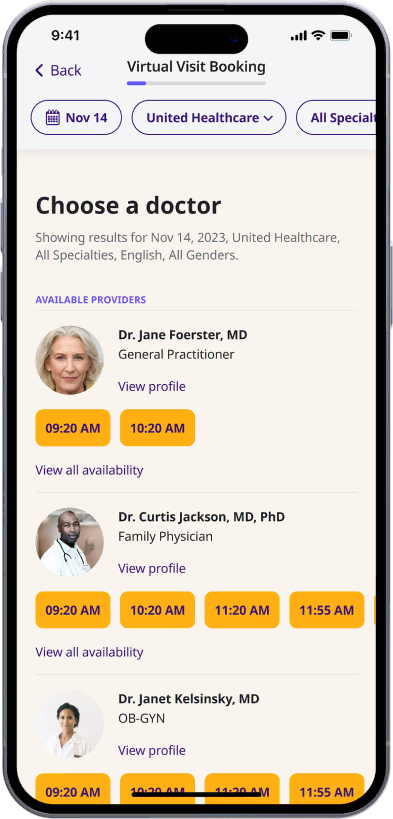
Start your video visit
Connect with a doctor in minutes on a secure video call.
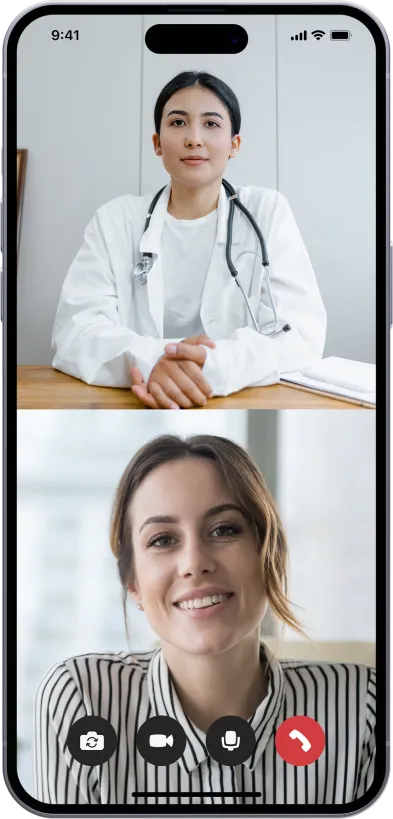
Get your prescription
Pick up your meds or have them delivered in as little as an hour.

Available in 50 states. Insurance accepted.
One-Time
Physician Visit
One-time visit with a physician for diagnosis, treatment, Rx, labs, referrals, and doctor’s notes.
Accepted Insurances
See why people turn to DrHouse...
As seen in

Back Pain Treatment Online
Back pain is a prevalent issue that affects millions of people worldwide and is one of the most common reasons for doctor visits and missed work. It can range from a dull, constant ache to a sudden, sharp sensation that makes it difficult to move.
Back pain is typically classified into two categories: acute and chronic. Acute back pain is sudden and often due to a specific injury or incident. It is usually temporary and improves within a few days or weeks with proper care. Chronic back pain, on the other hand, is more persistent and can develop gradually over time, often without a clear cause.
Causes of back pain
Back pain is a complex condition with a variety of underlying causes, affecting individuals of all ages. Understanding the main causes is essential for both effective treatment and prevention.
Mechanical causes
The most common cause of back pain is mechanical issues involving the spine, muscles, ligaments, and joints. This can include:
- Muscle or ligament strain: Repeated heavy lifting or a sudden awkward movement can strain back muscles and spinal ligaments. If your body is not conditioned, constant strain on your back can cause painful muscle spasms.
- Bulging or ruptured disks: Disks act as cushions between the bones (vertebrae) in your spine. The soft material inside a disk can bulge or rupture and press on a nerve, leading to back pain. However, it’s important to note that you can have a bulging or ruptured disk without back pain—disk disease is often found incidentally during spinal imaging for another reason.
- Arthritis: Osteoarthritis can affect the lower back. In some cases, arthritis in the spine can lead to a narrowing of the space around the spinal cord, a condition called spinal stenosis.
- Skeletal irregularities: Back pain can also occur when there are abnormalities in the spine such as scoliosis, or a curvature of the spine that can lead to pain, usually in adulthood.
Degenerative causes
As people age, the risk of developing back pain from degenerative disc disease or spondylosis increases. These conditions result from the wear and tear on a spine over time.
- Degenerative disc disease: This refers to the changes in the spinal discs as a part of the natural aging process. As you age, your spinal discs lose hydration and elasticity, which reduces their ability to cushion the vertebrae and can cause pain.
- Spondylosis: Often known as spinal osteoarthritis, it involves the gradual deterioration of the spinal joints and can lead to chronic stiffness and pain.
Other causes
Several other factors can contribute to or exacerbate back pain:
- Injury: Car accidents, falls, and sports injuries can cause back pain, often resulting from acute trauma to the spinal region.
- Lifestyle factors: Poor posture, obesity, and weak abdominal muscles disrupt the spine’s balance, causing the back to be strained and leading to pain over time.
- Psychological stress: Stress can affect the body in various ways, including causing muscle tension and tightening, which can contribute to back pain.
- Infections and illnesses: In some cases, back pain can be caused by conditions like infections of the spine (osteomyelitis), cancer that metastasizes to the spine, or inflammatory diseases such as ankylosing spondylitis.
Symptoms of back pain
Symptoms of back pain can vary widely depending on the underlying cause, the severity of the condition, and individual factors like age and overall health.
Here are some of the most common symptoms associated with back pain:
- Persistent aching or stiffness: This can occur anywhere along your spine, from the base of the neck to the tailbone.
- Sharp, localized pain: This type of pain is typically felt in the lower back. It may be confined to a single area and can be exacerbated by certain activities or lifting heavy objects.
- Radiating pain: This pain may radiate from the lower back to the buttocks, thighs, or even down to the calves and toes. It is often worse after prolonged sitting or standing. Sciatica is a common form of pain that radiates along the path of the sciatic nerve due to pressure on or irritation of this nerve.
- Muscle spasms: These can occur in response to injury or inflammation. They are usually involuntary and painful, and they can severely restrict your movement.
Pain that worsens with certain activities or positions
- Sitting for an extended period: Back pain that gets worse after sitting for a long time can be a symptom of several back issues, including sciatica or degenerative disc disease.
- Bending, lifting, standing, or walking: Pain that intensifies during these activities can indicate a mechanical problem in the spine, such as a herniated disc or a muscle strain.
- Relief upon lying down: Many people find that lying down helps to decrease back pain, especially pain that is due to muscle strain or a herniated disc.
Accompanying symptoms
- Numbness or tingling: These sensations can occur in the affected areas or in the arms and legs, depending on where the spinal nerves are involved.
- Weakness: Muscle weakness in the legs or feet can also accompany back pain and may be a sign of nerve compression.
Signs of serious medical conditions
Some symptoms associated with back pain may indicate a more serious condition and require immediate medical attention:
- Fever: A high temperature along with back pain can suggest an infection.
- Unexplained weight lloss: If back pain comes with rapid weight loss that cannot be explained by changes in your diet or exercise habits, it could be a sign of a serious medical condition, such as cancer.
- Bladder or bowel problems: If you experience changes in bladder or bowel control, this could be a sign of cauda equina syndrome, a serious neurological condition that requires urgent medical intervention.
- Severe, constant pain at night: Pain that is severe enough to disrupt your sleep can indicate serious underlying conditions such as tumors or infections.
If you experience any of these symptoms, it’s important to consult with a healthcare provider to determine the underlying cause and appropriate treatment.
Telehealth services, like those provided by DrHouse, can be an accessible starting point for advice and management, especially if you are experiencing mild to moderate symptoms that have not been associated with more severe underlying conditions.
Back pain treatment
Treating back pain involves a combination of approaches tailored to the individual’s specific symptoms and underlying causes. Here are some common methods used to treat back pain:
- Non-pharmacological treatments
- Physical therapy: Physical therapists can teach you how to sit, stand, and move in a way that keeps your spine in proper alignment and alleviates strain on your back. They also use techniques such as ultrasound, electrical stimulation, and muscle-release techniques to relieve pain.
- Exercise: Regular exercise helps to strengthen the muscles that support your back and reduces stiffness. A routine might include stretching, strength training, and aerobic activities. Core strengthening exercises can be particularly beneficial as they support the spine.
- Heat and cold Therapy: Applying heat or cold may relieve back pain. Ice packs are useful for reducing inflammation and numbing areas of pain. Heat therapy stimulates blood flow and soothes discomfort.
- Medical treatments
- Medications: Depending on the intensity and type of your back pain, doctors might recommend:
- Over-the-counter pain relievers such as ibuprofen or acetaminophen.
- Muscle relaxants if mild to moderate back pain does not improve with pain relievers.
- Topical pain relievers, which are creams, salves or ointments you can rub into your skin at the site of your pain.
- For more severe pain, stronger medications such as opioids might be temporarily prescribed under close supervision.
- Injections: If other measures don’t relieve your pain and if your pain radiates down your leg, your doctor might recommend an injection of a corticosteroid medication into the area around the spinal cord (epidural space). A corticosteroid can help decrease inflammation around the nerve roots, but the pain relief usually lasts less than a few months.
- Medications: Depending on the intensity and type of your back pain, doctors might recommend:
- Surgical treatments: Surgery is usually the last resort and is reserved for cases where there is structural damage that needs to be corrected or if the pain is caused by a serious underlying condition like a herniated disc or spinal stenosis.
Using telehealth for back pain treatment
Telehealth services like DrHouse provide convenient access to healthcare professionals who can evaluate your symptoms and provide guidance on whether home treatment is appropriate or if more advanced care is needed. They can also prescribe medications, recommend physical therapy, and, if necessary, refer you to specialists.
Combining these treatments often yields the best results. It’s important to work with a healthcare provider to determine the best treatment plan based on the specific cause and severity of your back pain.
Why choose DrHouse?
DrHouse offers convenient and accessible telehealth services for the management of back pain. Here are some reasons to consider using DrHouse:
- Accessibility – DrHouse provides telehealth services across all 50 states, making it widely accessible to a diverse range of patients. This nationwide coverage ensures that whether you’re in a rural or urban setting, you can access quality healthcare.
- Convenience – With DrHouse, seeing a doctor is made simple and efficient. You can start a virtual visit with less than a 15-minute wait time. This convenience is a major benefit for patients with busy schedules or for those who find it challenging to visit a doctor’s office physically.
- Comprehensive care – DrHouse offers a variety of services including urgent care, primary care, and specialty consultations. Whether you need a new prescription, a consultation for a chronic condition, or urgent medical advice, DrHouse can provide comprehensive healthcare remotely.
- Cost-effective – Telehealth visits with DrHouse are generally less expensive compared to traditional in-person visits. The service provides a flat-rate pricing model, which can be particularly beneficial for individuals without insurance or those with high deductible plans.
- Prescriptions and referrals – DrHouse can handle prescriptions directly through the platform, sending them to your local pharmacy for easy pickup or delivery. If specialized care is needed, DrHouse can also facilitate referrals to specialists.
- Flexible – The platform is designed to meet the needs of modern patients who value flexibility. The ability to get medical advice, prescriptions, and follow-up care without the need for scheduling weeks in advance or traveling to a doctor’s office supports a modern, on-the-go lifestyle.
Frequently asked questions

